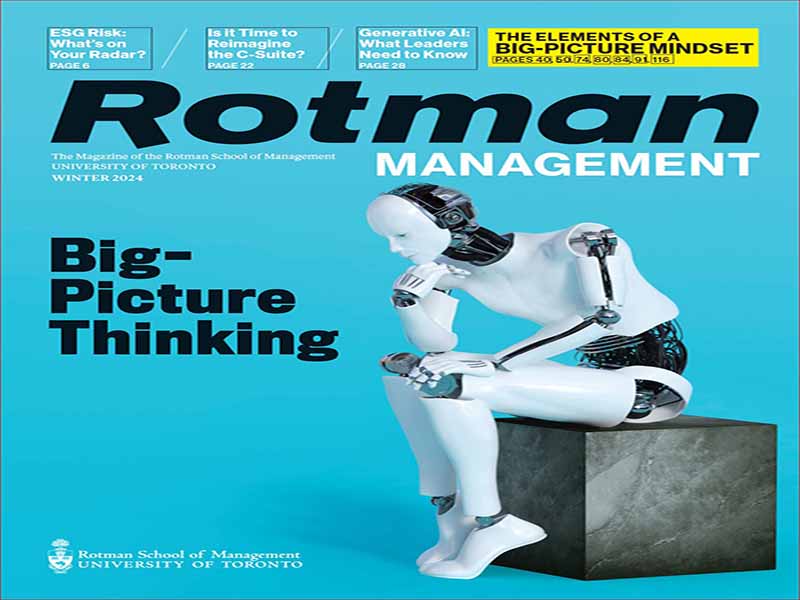- عنوان کتاب: Rotman’s executive leadership program
- نویسنده: Rotman
- حوزه: هدایت و رهبری
- سال انتشار: 2024
- تعداد صفحه: 124
- زبان اصلی: انگلیسی
- نوع فایل: pdf
- حجم فایل: 24.2 مگابایت
در سال 1994، جف بزوس در امور مالی در شهر نیویورک کار می کرد. اینترنت به تازگی در حال ظهور بود، اما با نرخ باورنکردنی بیش از 2300 درصد در سال رشد می کرد. او یک تجلی داشت: تجارت الکترونیک آینده بود. بزوس تحقیقاتی انجام داد و متوجه شد که کتاب ها از محبوب ترین اقلام خرده فروشی هستند. بنابراین او وسایل خود را جمع کرد، به سیاتل نقل مکان کرد و آمازون را از گاراژ خود راه اندازی کرد. چشم انداز او: تبدیل شدن به بزرگترین کتابفروشی آنلاین جهان. منتقدان تمسخر کردند، اما بزوس دید که چگونه برخی از قطعات مهم پازل با هم تطابق می یابند: ظهور اینترنت، افزایش مالکیت کامپیوتر، و سادگی فروش آنلاین کتاب. این تفکر بزرگ او را به یکی از موفق ترین کارآفرینان زمان ما تبدیل کرده است. بیشتر نوآوریهای پیشرفتهای که امروزه از آن لذت میبریم، نتیجه تفکر تصویری بزرگ است، که میتواند به عنوان «توانایی دید وسیع از هر موقعیت یا ابتکاری» تعریف شود – کوچکنمایی و مشاهده اینکه چگونه چیزها به هم مرتبط هستند. . و این یک قابلیت فزاینده مهم برای رهبران است. متفکران تصویر بزرگ به جای گیر کردن «در علف های هرز» می توانند پیامدهای گسترده یک پروژه یا تصمیم خاص را تصور کنند. پرورش این طرز فکر به تمرین نیاز دارد، اما نیمی از نبرد تضمین این است که شما درک دقیقی از مسائل کلیدی امروزی داشته باشید – که از خطرات و فرصتهای پیرامون محیطی، اجتماعی و حاکمیت (ESG) و تنوع، برابری و شمول (DEI) تا فناوریهای نوظهور را شامل میشود. مانند هوش مصنوعی با هدف عمومی و چشم انداز مالی غیرمتمرکز (DeFi). همه باعث ایجاد تغییر در صنایع هستند. در این شماره، برخی از دانش ها و ابزارهای مورد نیاز برای دیدن و درک تصویر بزرگ را ارائه خواهیم کرد. استادیار روتمن ریچارد پاورز و همکارانش می گویند زمان آن فرا رسیده است که مدیران اجرایی با ذینفعان برای شناسایی، ارزیابی و گزارش خطرات ESG خود همکاری کنند – و مدیریت آنها را به عنوان بخشی از عملیات روزانه خود آغاز کنند. خطر ESG: در رادار شما چیست؟ در صفحه 6 آغاز می شود. در صفحه 28، کریش بانرجی از Accenture توضیح می دهد که در دهه آینده، “مدل های بنیاد” هوش مصنوعی ماهیت اشتراک دانش در سازمان ها را تغییر خواهد داد، در هوش مصنوعی مولد: آنچه رهبران باید بدانند. و در صفحه 74، پروفسور روتمن ولید حجازی و فریدا خان، معاون مدیر آموزش جهانی و تجربی مدرسه، استدلال میکنند که هوش فرهنگی (CQ) نادیده گرفتهشدهترین عنصر برای موفقیت تجارت جهانی است، در هوش فرهنگی: مهارت قرن. در جای دیگر این شماره، ما با پروفسور وارتون، مائورو گیلن، در مورد «عصر همیشگی» در مصاحبه با رهبر فکر در صفحه 14 صحبت می کنیم. ادنا لوپز آویلا، کاندیدای دکترای روتمن و چارلز مارتینو، استادیار امور مالی، نشان میدهند که وقتی نوبت به سرمایهگذاری میرسد، جمعیت همیشه عاقل نیستند، در صفحه 60. و دو فارغالتحصیل روتمن – ویکتور تونگ (MBA ’12) و چارلی باتلر (MBA ’20) – در صفحه 66 نشان میدهند که چگونه میتوان عاملی برای تغییرات مثبت شد. آنها همچنین می توانند به آنها کمک کنند تا فرصت های جدید را در آغوش بگیرند و در عین حال به کار با اصولی ادامه دهند که برای بلندمدت شرکت های پایدار ایجاد می کند. البته، سازمان ها برای پیشرفت به چیزی بیش از تفکر تصویری بزرگ نیاز دارند. آنها همچنین به افرادی در انتهای دیگر طیف نیاز دارند – متفکران جزئیات گرا که می توانند از دقت، دقت و توانایی چرخش در صورت نیاز اطمینان حاصل کنند. مانند بسیاری از چیزهای زندگی، همه چیز در مورد دستیابی به تعادل است. در دنیای پیچیده، سازمان ها برای بدست آوردن یک تصویر کامل به دیدگاه های متعدد نیاز دارند. و در نتیجه، موثرترین تیم های رهبری قادر به بزرگنمایی و کوچکنمایی هستند.
IN 1994, JEFF BEZOS was working in finance in New York City. The Internet was just emerging, but it was growing at an incredible rate of over 2,300 per cent per year. He had an epiphany: e-commerce was the future. Bezos did some research and discovered that books were among the most popular retail items. So he packed up, moved to Seattle, and launched Amazon out of his garage. His vision: to become the world’s largest online bookstore. Critics scoffed, but Bezos saw how some critical puzzle pieces fit together: the rise of the Internet, growing computer ownership, and the simplicity of online book selling. This bigpicture thinking has made him one of the most successful entrepreneurs of our time. Most of the cutting-edge innovations we enjoy today are the result of big-picture thinking, which can be defined as ‘the ability to take a wide-angle view of any situation or initiative’ — to zoom out and see how things are interconnected. And this is an increasingly important capability for leaders. Rather than getting stuck ‘in the weeds,’ big-picture thinkers can imagine the far-reaching implications of a particular project or decision. Cultivating this mindset takes practice, but half the battle is ensuring you maintain a keen understanding of today’s hotbutton issues — which range from risks and opportunities around environmental, social and governance (ESG) and diversity, equity and inclusion (DEI), to emerging technologies like general purpose AI and the decentralized finance (DeFi) landscape. All are driving change across industries. In this issue, we will present some of the knowledge and tools required to see and understand the big picture. Rotman Associate Professor Richard Powers and his co-authors say the time has come for executives to collaborate with stakeholders to identify, assess and report on their ESG risks — and to start managing them as part of their daily operations. ESG Risk: What’s on Your Radar? begins on page 6. On page 28, Accenture’s Krish Banerjee explains that over the next decade, AI ‘foundation models’ will transform the nature of knowledge sharing within organizations, in Generative AI: What Leaders Need to Know. And on page 74, Rotman Professor Walid Hejazi and the School’s Associate Director of Global and Experiential Learning Freeda Khan argue that cultural intelligence (CQ) is the most overlooked ingredient for global business success, in Cultural Intelligence: The Skill of the Century. Elsewhere in this issue, we talk to Wharton Professor Mauro Guillén about ‘the Age of the Perrennial’ in our Thought Leader Interview on page 14; Rotman PhD Candidate Edna Lopez Avila and Assistant Professor of Finance Charles Martineau show that when it comes to investing, crowds are not always wise, on page 60; and two Rotman alumni — Victor Tung (MBA ’12) and Charley Butler (MBA ’20) — show how to become an agent for positive change on page 66. Big-picture thinkers can help their organizations respond to events before they become crises. They can also help them embrace new opportunities while continuing to operate with principles that build sustainable enterprises for the long run. Of course, organizations need more than big-picture thinking to thrive. They also need people at the other end of the spectrum — detail-oriented thinkers who can ensure precision, accuracy and an ability to pivot as needed. As with so many things in life, it’s all about achieving a balance. In a complex world, organizations need multiple perspectives to get a complete picture. And as a result, the most effective leadership teams are able to zoom in and zoom out.
این کتاب را میتوانید از لینک زیر بصورت رایگان دانلود کنید:
Download: Rotman’s executive leadership program



































نظرات کاربران